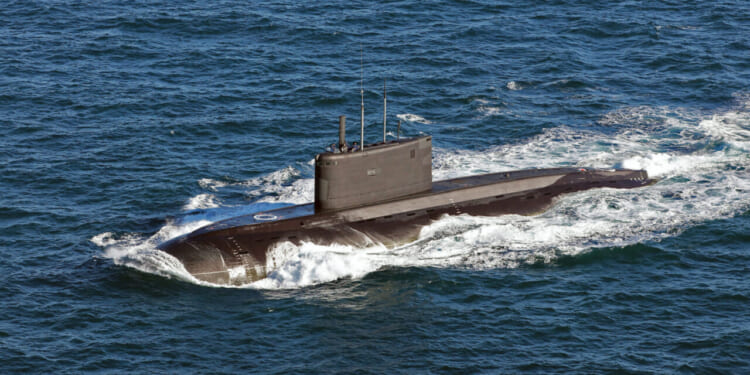Moscow’s naval fleet just suffered another embarrassing setback. Earlier this month, one of its most advanced submarines had to surface due to technical problems. Although the Kremlin publicly stated that its diesel-powered Kilo II-class vessel had only surfaced in order to comply with navigation rules while traversing the English Channel, Dutch authorities confirmed it was indeed towed in the North Sea. NATO chief Mark Rutte mocked the incident, noting, “What a change from the 1984 Tom Clancy novel The Hunt for Red October. Today, it seems more like the hunt for the nearest mechanic.” Rutte added that hardly any Russian vessels at all were positioned in the Mediterranean today. It appears Russia’s “permanent task force” established in the Mediterranean back in 2013 has nearly all but been dismantled.
The Russian submarine, which reportedly required a tow back home, is the Novorossiysk B-261. As the lead ship of the Improved Kilo II diesel-electric attack submarine class, Novorossiysk sports enhancements that make it more capable than its predecessors. The original Kilo submarines were designed by the Soviet Union during the Cold War. Meant to function as part of the USSR’s anti-shipping and anti-submarine operations in shallow waters, the Kilo vessels were designed to be able to locate enemy subs at ranges three to four times greater than they themselves could be detected. Over the last 40 years, more than 70 Kilo-class boats have been constructed, and many remain in service with navies across the globe. This submarine class first entered service in 1980 under the designation Project 877 Paltus. The vessels have undergone several retrofits over the years to incorporate new technologies, culminating in the latest improved Kilo II contingent.
The Novorossiysk Submarine
Novorossiysk was the first Kilo II submarine to be introduced to service with the Russian Navy back in 2010. The Kilo II vessels displace approximately 2,350 tons surfaced and measure roughly 242 feet long with a 32.5-foot beam. Unlike their predecessors, the Kilo II submarines are capable of launching Kalibr cruise missiles. Russian state-run media outlets report that this family of missiles can sport both thermonuclear warheads and warheads with up to 1,100 pounds of explosives. In total, the Kilo boats are fitted with half a dozen 21-inch bow torpedo tubes that can launch torpedoes or naval mines. But since this class only has space to carry a maximum of 18 torpedoes or two dozen naval mines, it can only lug four Kalibr missiles each as part of its armament package.
Despite the Kilo II’s progress when compared to earlier class iterations, these submarines are certainly not considered to be “top tier.” In addition to Novorossiysk’s reported tow, Moscow’s Navy has been struggling altogether in the Mediterranean. While Russia had maintained a base at Tartus, Syria, after the Middle East nation’s civil war erupted, the collapse of the Assad regime last year forced Moscow to go without a foothold in the region.
About the Author: Maya Carlin
Maya Carlin, National Security Writer with The National Interest, is an analyst with the Center for Security Policy and a former Anna Sobol Levy Fellow at IDC Herzliya in Israel. She has by-lines in many publications, including The National Interest, Jerusalem Post, and Times of Israel. You can follow her on Twitter: @MayaCarlin. Carlin has over 1,000 articles published over the last several years on various defense issues.
Image: LA(Phot) Guy Pool/MOD, OGL v1.0, Wikimedia Commons.

















